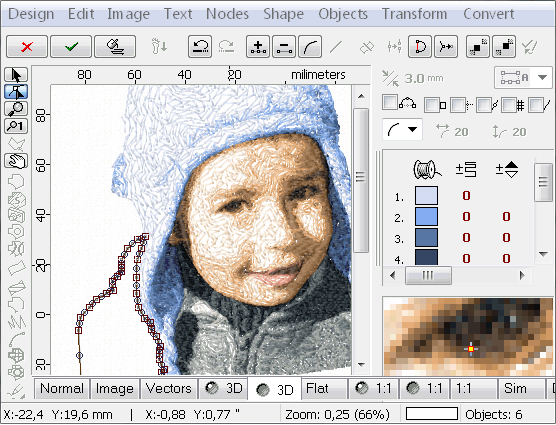Explore Various Sorts Of Embroidery Digitizing Methods
Needlework digitizing has developed substantially for many years, supplying a myriad of techniques to bring layouts to life in the digital realm. From the detailed artistry of conventional hand needlework digitizing to the precision of the boxing strategy, and the convenience of auto-digitizing software programs, the alternatives are huge. The world prolongs to much more sophisticated techniques like photorealistic needlework digitizing and the remarkable realm of 3D needlework digitizing. Each strategy brings a distinct collection of possibilities and challenges to the table, making the expedition of these techniques a compelling journey for those in the embroidery globe.
Typical Hand Embroidery Digitizing
Standard hand embroidery digitizing involves the process of converting elaborate hand-stitched designs into digital formats for device embroidery. This method requires knowledgeable craftsmens to thoroughly evaluate the handmade design and after that utilize specialized software program to recreate it in an electronic layout. Each stitch, color, and information should be meticulously equated to ensure that the significance of the initial hand embroidery is preserved in the electronic variation.
Among the essential obstacles of typical hand embroidery digitizing is recording the intricacies and subtleties of the handmade style. Digitizing for Embroidery. Artisans should have a deep understanding of various needlework strategies, such as satin stitch, chain stitch, and French knots, to accurately reproduce these techniques in the electronic world. Furthermore, they need to have an eager eye for information to guarantee that the electronic layout maintains the exact same level of creativity and workmanship as the initial hand-stitched item
Punching Technique
To perfectly transition from traditional hand needlework digitizing to the boxing method, craftsmens must currently concentrate on transforming the complex digital styles into instructions that needlework makers can translate. The boxing technique entails using specialized software application to create digital files which contain commands for the embroidery device to follow. This process calls for a deep understanding of not just the style itself however additionally the capacities and limitations of the embroidery equipment.

Auto-Digitizing Software Programs
Needlework digitizing has been transformed by the development of auto-digitizing software application programs, offering craftsmens with sophisticated tools to convert digital designs right into needlework maker instructions efficiently. Auto-digitizing software programs use formulas to evaluate digital pictures or vector documents and produce embroidery designs automatically. These programs permit for quick and exact conversion of intricate designs into stitch patterns, conserving time and effort for embroiderers.
One of the vital benefits of auto-digitizing software program is its easy to use important source user interface, making it easily accessible to both newbies and seasoned digitizers. These programs commonly consist of features such as stitch next page editing and enhancing tools, thread color matching, and the capacity to sneak peek the final embroidered style. Additionally, auto-digitizing software can take care of intricate designs with several colors and complex information, producing top notch embroidery data ideal for various apparel and fabric tasks.
While auto-digitizing software application provides convenience and effectiveness, it is important for users to understand the constraints of automated digitizing. Fine-tuning and manual changes may still be required to attain the desired needlework quality, especially when managing complex or distinct styles. By leveraging the capabilities of auto-digitizing software alongside hands-on digitizing techniques, artisans can boost their embroidery digitizing process and produce sensational stitched items.
Photorealistic Embroidery Digitizing
Utilizing sophisticated digital imaging strategies, accomplishing photorealistic lead to needlework digitizing has actually come to be a sought-after ability amongst modern-day craftsmens. This method entails transforming high-resolution images into elaborate stitch patterns that closely imitate the original design, causing embroidery items that display realistic information and depth.
To achieve photorealistic embroidery digitizing, craftsmens have to possess a keen eye for information and a comprehensive understanding of exactly how different stitch types and densities can influence the last end result. By meticulously mapping out each shade and shade in the picture, embroiderers can create an electronic documents that guides the needlework equipment to reproduce the subtleties of the original photo properly.
Photorealistic embroidery digitizing is specifically popular in creating custom-made designs for apparel, home decoration, and art items where catching the significance of a picture or art work is vital. This technique enables craftsmens to transform memories, landscapes, pictures, and intricate art work into magnificent embroidered masterpieces that display a blend of traditional craftsmanship and innovative innovation.
3D Needlework Digitizing
With the improvement of digital imaging strategies in attaining photorealistic lead to needlework digitizing, the exploration of 'D Embroidery Digitizing' supplies a brand-new measurement to the ins and outs of design duplication. 'D Embroidery Digitizing' describes the three-dimensional digitizing strategy that adds depth and appearance to needlework designs, creating an extra practical and visually enticing end product. This technique uses software program that imitates the result of light and darkness on the embroidery layout, improving its Home Page overall visual impact.
One of the essential benefits of 'D Needlework Digitizing' is its capacity to make designs look even more realistic and dynamic. By including deepness to the needlework design, the end product appears much more practical and fascinating (Digitizing for Embroidery). In addition, this technique permits even more creative flexibility in design implementation, allowing embroiderers to trying out various appearances and results that were formerly testing to achieve
Final Thought

Comments on “Efficient Digitizing for Embroidery: Quick Turnaround”